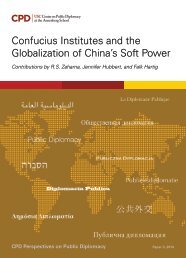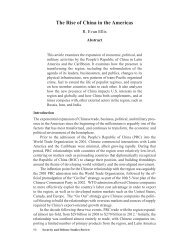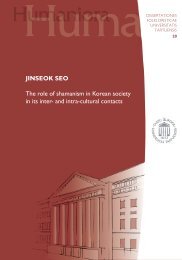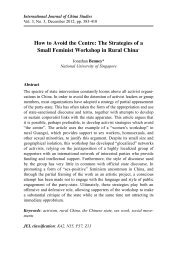JennyChan.PhDThesis.2014.FINAL
JennyChan.PhDThesis.2014.FINAL
JennyChan.PhDThesis.2014.FINAL
Create successful ePaper yourself
Turn your PDF publications into a flip-book with our unique Google optimized e-Paper software.
considerable extent as foreigners rather than as capitalists.” 81<br />
Some others did not<br />
exhibit anti-imperial sentiments. Importantly, women workers in large<br />
foreign-owned cotton mills, instead of small family shops or Chinese-run factories,<br />
were relatively contented with their pay and working conditions. To some, foreign<br />
bosses provided them with a relatively stronger sense of economic and social<br />
security compared to often more abusive labor contractors linked to local gangs. This<br />
close attention to workers’ subjective experience and world views 82 is insightful: the<br />
formation of a collective identity as women and as workers, the consciousness of<br />
working-class interests, the participation in political and economic strikes, or the<br />
lack thereof, cannot be divorced from workers’ concrete situations in their workplace,<br />
the industry, and the larger society. 83<br />
With the nationalization of industries during the 1950s through 1970s, the Chinese<br />
workers were liberated from capitalist exploitations. Under central planning, new<br />
workers, including peasant migrants settling in the city during the early years of the<br />
establishment of the People’s Republic, were provided with an “iron rice bowl” of<br />
permanent job tenure. The grades of wage rates were compressed to ensure a high<br />
level of income equality across urban work units. 84 In the countryside, wealth<br />
distinctions between individual households were also minimized as farming and<br />
rural industries were collectivized. While urban-rural structural inequality remained,<br />
partly due to uneven geographical endowments and partly because of government<br />
development policies that favored workers over peasants, scholars note that the level<br />
was relatively low when compared to other Third World countries during the same<br />
period. 85 After the death of Mao Zedong in 1976 and the restoration of political<br />
stability, the central leadership under Deng Xiaoping introduced a series of rural<br />
reforms and foreign trade policies. Inequality widens and class conflict deepens. The<br />
set up of Special Economic Zones in Shenzhen and Shekou in South China in 1980<br />
81 Emily Honig, 1986, Sisters and Strangers: Women in the Shanghai Cotton Mills, 1919-1949,<br />
Stanford, California: Stanford University Press, p. 247.<br />
82 Charles Sabel in Work and Politics: The Division of Labor in Industry (Cambridge: Cambridge<br />
University Press, 1982, p. 11) gives this definition: “The set of hopes and fears, together with the map<br />
of the social world that it establishes, is called a world view.”<br />
83 Elizabeth J. Perry, 2002, Challenging the Mandate of Heaven: Social Protest and State Power in<br />
China, Armonk, NY: M.E. Sharpe, ch. 5.<br />
84 Andrew G. Walder, 1986, Communist eo-Traditionalism: Work and Authority in Chinese Industry,<br />
Berkeley: University of California Press; Stephen Andors, 1977, China’s Industrial Revolution:<br />
Politics, Planning, and Management, 1949 to the Present, NY: Pantheon Books; Charles Hoffman,<br />
1974, The Chinese Worker, Albany, NY: State University of New York Press; Gail E. Henderson, and<br />
Myron S. Cohen, 1984, The Chinese Hospital: A Socialist Work Unit, New Haven: Yale University<br />
Press; Mark W. Frazier, 2002, The Making of the Chinese Industrial Workplace: State, Revolution,<br />
and Labor Management, Cambridge, UK: Cambridge University Press.<br />
85 See, for example, Mark Selden, 1993, The Political Economy of Chinese Development, Armonk,<br />
NY: M. E. Sharpe.<br />
26






